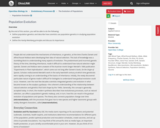
- Material Type:
- Full Course
- Provider:
- Rice University
- Provider Set:
- OpenStax College
- Date Added:
- 03/07/2018



By the end of this section, you will be able to do the following:
Define population genetics and describe how scientists use population genetics in studying population evolution
Define the Hardy-Weinberg principle and discuss its importance


By the end of this section, you will be able to do the following:
Explain the relationship between genotypes and phenotypes in dominant and recessive gene systems
Develop a Punnett square to calculate the expected proportions of genotypes and phenotypes in a monohybrid cross
Explain the purpose and methods of a test cross
Identify non-Mendelian inheritance patterns such as incomplete dominance, codominance, recessive lethals, multiple alleles, and sex linkage

By the end of this section, you will be able to do the following:
Explain Mendel’s law of segregation and independent assortment in terms of genetics and the events of meiosis
Use the forked-line method and the probability rules to calculate the probability of genotypes and phenotypes from multiple gene crosses
Explain the effect of linkage and recombination on gamete genotypes
Explain the phenotypic outcomes of epistatic effects between genes

By the end of this section, you will be able to do the following:
Describe the scientific reasons for the success of Mendel’s experimental work
Describe the expected outcomes of monohybrid crosses involving dominant and recessive alleles
Apply the sum and product rules to calculate probabilities